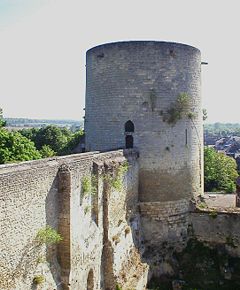
Château de Gisors
Encyclopedia

Gisors
Gisors is a commune in the metropolitan area of Paris, France. It is located northwest from the center of Paris.Gisors, together with the neighbouring communes of Trie-Château and Trie-la-Ville, form an urban area of 12,669 inhabitants...
in the départment
Department
A department is a part of a larger organization with a specific responsibility. For the division of organizations into departments, see departmentalization.In particular:...
of Eure
Eure
Eure is a department in the north of France named after the river Eure.- History :Eure is one of the original 83 departments created during the French Revolution on 4 March 1790...
, France
France
The French Republic , The French Republic , The French Republic , (commonly known as France , is a unitary semi-presidential republic in Western Europe with several overseas territories and islands located on other continents and in the Indian, Pacific, and Atlantic oceans. Metropolitan France...
.
History
The castle was a key fortress of the Dukes of Normandy in the 11th and 12th centuries. It was intended to defend the Anglo-NormanAnglo-Norman
The Anglo-Normans were mainly the descendants of the Normans who ruled England following the Norman conquest by William the Conqueror in 1066. A small number of Normans were already settled in England prior to the conquest...
Vexin
Vexin
The Vexin is a historical county of northwestern France. It covers a verdant plateau on the right bank of the Seine comprising an area east-to-west between Pontoise and Romilly-sur-Andelle , and north-to-south between Auneuil and the Seine near Vernon...
territory from the pretensions of the King of France. In 1193, the castle fell into the hands of the King of France and thereafter lost a good part of its importance as a frontier castle.
It is also known for its links with the Templars
Knights Templar
The Poor Fellow-Soldiers of Christ and of the Temple of Solomon , commonly known as the Knights Templar, the Order of the Temple or simply as Templars, were among the most famous of the Western Christian military orders...
. Put into their charge by the French king between 1158 and 1160, it became the final prison of the Grand Master of the Order, Jacques de Molay
Jacques de Molay
Jacques de Molay was the 23rd and last Grand Master of the Knights Templar, leading the Order from 20 April 1292 until it was dissolved by order of Pope Clement V in 1312...
, in 1314.
Description of the château
The first building work is dated to about 1095, and consisted of a motteMotte-and-bailey
A motte-and-bailey is a form of castle, with a wooden or stone keep situated on a raised earthwork called a motte, accompanied by an enclosed courtyard, or bailey, surrounded by a protective ditch and palisade...
, which was enclosed in a spacious courtyard or bailey. Henry I of England
Henry I of England
Henry I was the fourth son of William I of England. He succeeded his elder brother William II as King of England in 1100 and defeated his eldest brother, Robert Curthose, to become Duke of Normandy in 1106...
, Duke of Normandy
Duke of Normandy
The Duke of Normandy is the title of the reigning monarch of the British Crown Dependancies of the Bailiwick of Guernsey and the Bailiwick of Jersey. The title traces its roots to the Duchy of Normandy . Whether the reigning sovereign is a male or female, they are always titled as the "Duke of...
, added an octagonal stone keep to the motte. After 1161, important reinforcement work saw this keep raised and augmented; the wooden palisade of the motte converted to stone, thus forming a chemise
Chemise (wall)
In medieval castles the chemise was typically a low wall encircling the keep, protecting the base of the tower. An alternative term, more commonly used in English is mantlet wall....
; and the outer wall of the bailey was completed in stone with flanking towers. A second keep, cylindrical in shape, called the Prisoner's Tower (tour du prisonnier), was added to the outer wall of the castle at the start of the 13th century, following the French conquest of Normandy
Normandy
Normandy is a geographical region corresponding to the former Duchy of Normandy. It is in France.The continental territory covers 30,627 km² and forms the preponderant part of Normandy and roughly 5% of the territory of France. It is divided for administrative purposes into two régions:...
. Further reinforcement was added during the Hundred Years' War
Hundred Years' War
The Hundred Years' War was a series of separate wars waged from 1337 to 1453 by the House of Valois and the House of Plantagenet, also known as the House of Anjou, for the French throne, which had become vacant upon the extinction of the senior Capetian line of French kings...
. In the 16th century, earthen ramparts were built.
The Château de Gisors is listed as a monument historique
Monument historique
A monument historique is a National Heritage Site of France. It also refers to a state procedure in France by which national heritage protection is extended to a building or a specific part of a building, a collection of buildings, or gardens, bridges, and other structures, because of their...
by the French Ministry of Culture.
Sources
- Mesqui, Jean, Chateaux-forts et fortifications en France, Paris: Flammarion, 1997, p. 493. ISBN 2-08-012271-1.
External links
- Article and photos on the château de Gisors
- - article and pictures
- Ministry of Culture database entries for Gisors:

